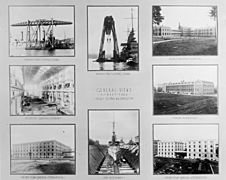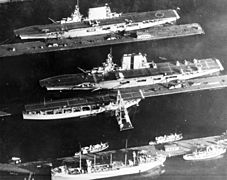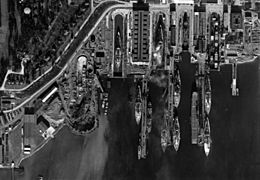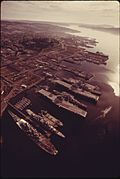Puget Sound Naval Shipyard facts for kids
|
Puget Sound Naval Shipyard
|
|

Four decommissioned aircraft carriers docked at the shipyard. From left: Independence, Kitty Hawk, Constellation and Ranger.
|
|
| Location | N shore of Sinclair Inlet, Bremerton, WA |
|---|---|
| Architect | US Navy |
| NRHP reference No. | 92001883 |
Quick facts for kids Significant dates |
|
| Added to NRHP | 27 August 1992 |
| Designated NHLD | 27 August 1992 |
| Puget Sound Naval Shipyard and Intermediate Maintenance Facility | |
|---|---|
| Puget Sound, Washington | |
| Type | Shipyard |
| Site information | |
| Controlled by | United States Navy |
| Site history | |
| Built | 1891 |
| In use | 1891–present |
| Garrison information | |
| Current commander |
CAPT James "Jip" Mosman (Dec. 2020 -present) |
The Puget Sound Naval Shipyard, also known as PSNS & IMF, is a very important place for the United States Navy. It's a huge shipyard that covers 179 acres (about 0.7 square kilometers) in Bremerton, Washington. It's located right on Puget Sound and has been used continuously since it was built in 1891.
This shipyard is bordered by Sinclair Inlet to the south and the city of Bremerton to the north and east. It's the biggest naval base in the Pacific Northwest. It's also one of the largest industrial places in Washington state. PSNS & IMF helps the Navy by doing maintenance, making ships more modern, and providing technical support. About 14,000 people work here.
Contents
History of the Shipyard
The Puget Sound Naval Shipyard started in 1891 as a naval station. It became known as Navy Yard Puget Sound in 1901.
During World War I, the shipyard built many ships. This included 25 subchasers, seven submarines, and many smaller boats.
In World War II, the shipyard's main job was to fix ships. They repaired battle damage for ships from the U.S. fleet and its allies.
After World War II, the name changed to Puget Sound Naval Shipyard. They worked on making aircraft carriers more modern. This included changing flight decks to angled ones. During the Korean War, the shipyard helped get ships ready for action.
In the late 1950s, the shipyard started building new ships. They built a new type of guided missile frigate. In 1965, the USS Sculpin (SSN 590) became the first nuclear submarine to be fixed here.
In 1992, the shipyard was named a National Historic Landmark. This means it's a very important historical place. The historic area includes many old buildings and structures.
Cool Features
One of the most noticeable things at the shipyard is its giant green hammerhead crane. It was built in 1933.
This crane is 250 feet (76 m) tall and 80 feet (24 m) wide. It can lift very heavy things, up to 250 tons!
Historic Areas
The Puget Sound Naval Shipyard has five special historic areas. These areas show the important history of the shipyard.
- Officers' Row Historic District
- Puget Sound Radio Station Historic District
- Hospital Reservation Historic District
- Puget Sound Naval Shipyard Historic District
- Marine Reservation Historic District
What They Do
Ship-Submarine Recycling Program
In 1990, the Navy started a program to recycle nuclear-powered ships. This is called the Ship-Submarine Recycling Program (SRP). About 25% of the shipyard's work is taking apart and recycling these ships.
The shipyard has found a safe way to recycle nuclear ships. This makes the U.S. Navy the only group in the world that designs, builds, uses, and recycles nuclear-powered ships. In 2003, PSNS and IMF joined together to become one facility.
PSNS is the only place in the U.S. that can recycle nuclear ships. Over the years, Puget Sound Naval Shipyard has recycled more than 125 submarines and some cruisers.
Reserve Fleet
The shipyard is also home to part of the U.S. Navy reserve fleet. This is a large group of Navy ships that are no longer active.
One of these ships is the aircraft carrier USS Kitty Hawk (CV-63). Kitty Hawk is "mothballed." This means it's stored safely in case the Navy needs it again in the future.
Environmental Care
Near Port Orchard, Washington, there's a place called Gorst Creek Ravine. This area was used to dump waste from the shipyard between 1969 and 1970.
Over time, some parts of the landfill have collapsed. This could affect nearby roads. The landfill is also a source of certain chemicals and metals. These can flow into the water and affect groundwater, fishing, and the Suquamish Tribe's fish hatchery. In 2014, the U.S. EPA (Environmental Protection Agency) told the Navy to fix these problems.
Gallery
Images for kids
-
Franklin D. Roosevelt delivers a radio address (August 12, 1944)
See also
 In Spanish: Astillero Naval de Puget Sound para niños
In Spanish: Astillero Naval de Puget Sound para niños












